Throughout its history, Santorini island in Greece has been shaped by volcanism. The island first appeared about two-million years ago when volcanic craters emerged from the Aegean Sea. Initially, the craters united into a small round island with a caldera in the center. Herodotus tells us that the island’s first name, Strongili (meaning “the round one”), came from that formation. Regular eruptions increased the size of the island, and eventually settlers arrived from other Cyclades islands like Naxos, Paris, and Mykonos. These “pre-Greeks” built Akrotiri, which became the island’s most important city. Today, Santorini island is the only inhabited caldera in the world, one of the fun facts about Greece that I learned from a story written by fellow travel writers Janice and George Mucalov on their Sand In My Suitcase blog.
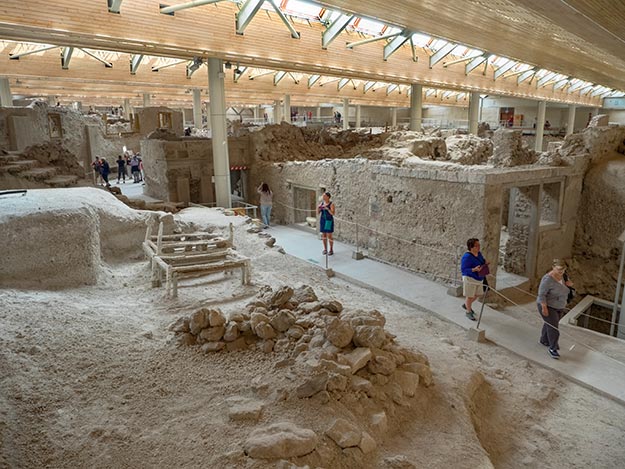
Around 1450 B.C., Santorini suffered one of the largest volcanic eruptions ever recorded on Earth. The Theran eruption, as it is known, broke the island into three pieces, allowing the sea to rush in and flood the caldera of the volcano. The flourishing town of Akrotiri, often referred to as the “Minoan Pompeii,” was simultaneously destroyed and preserved by ash from that massive eruption. It lay buried and forgotten for centuries, until it was rediscovered by archeologists in the middle of the 19th century.
To date, about 30 buildings (an estimated ten percent of ancient Akrotiri) have been excavated in what would have been the the city’s main port. The architecture of the buildings was advanced. Many were three stories high, built of carved volcanic stones and held together with mud cement. Homes were equipped with inside toilets and many walls were decorated with intricate frescoes that depicted scenes from distant lands, proving that Akrotirians were well-traveled.
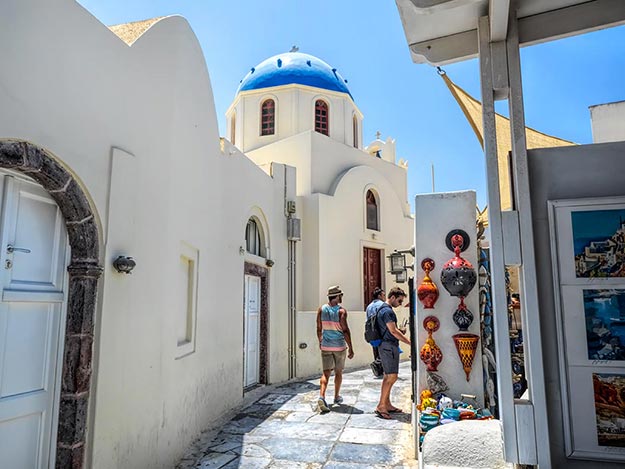
Since no human remains and few items of value have been found, archeologists believe the residents may have been forewarned by an earthquake that prompted them to abandon the city. The discovery of beds sitting outside of homes seems to support this theory, as it is a sure sign they’d been experiencing earthquakes. However, experts don’t believe residents left the island, because they would have known about tsunamis. It is more likely that they evacuated to higher ground. With 90% of Akrotiri still buried, archeologists speculate that a mass grave may be discovered as excavations move further inland. It will take generations of archeological work to piece together the entire story.

Although the Theran eruption occurred more than 3,500 years ago, evidence of it is visible today. The three broken islands still form a semi-circle around the caldera, with the dormant volcano at its center. Several other islands emerged from the caldera over the ensuing centuries, as molten magma continued to pour from the sea floor. Perhaps the best view of this astonishing landscape is from Santo Winery, where we stopped for an hour-long wine tasting. While others sampled the goods, I wandered outside to a broad balcony that overhangs the caldera. From that vantage point, the circular footprint of the original volcano was clear to see, but it was still incomprehensible to me the immensity of the explosive power that would have been necessary to blow away all but the jagged rim.
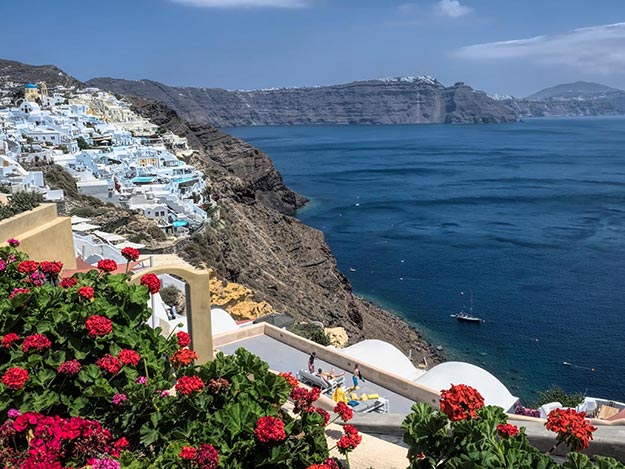
Today a small number of locals eek out a living growing crops and fishing, and wine is an important industry. However the island’s main source of income is tourism and the town of Oia (pronounced EE-yah) is the epicenter for tourists. Located on the furthest northern tip of the island, Oia was one of the most important settlements during the 13th and 14th centuries, when Venetians occupied the island. An important trade center, it was built on the virtually unassailable northern side of the caldera.
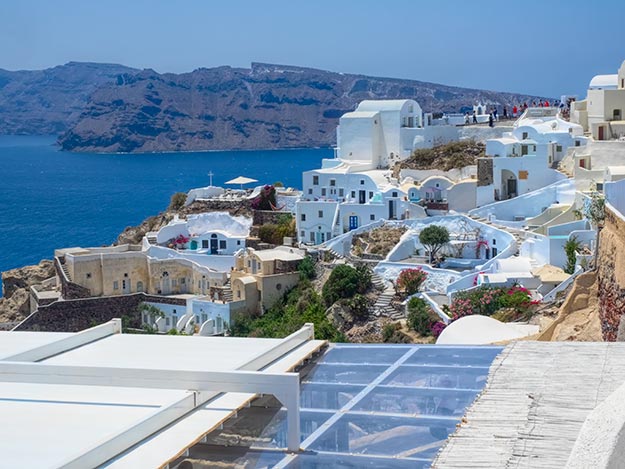
During Medieval times, Oia exported wine and imported white marble, which they used to pave their main street. Wealthy ship captains, traders, and merchants built traditional domed houses along the marble thoroughfare. These “Tholos”, as they are known, are more resistant to earthquakes. Even today, almost every home on Santorini has at least one domed roof. Poorer residents of the city dug traditional cave houses into the sides of the caldera. Known as “Yposkafa” in Greek, these “caves” have long since been acquired by the rich and incorporated into the expensive shops and hotels that line the white marble way.

Frankly, on the day our tour group visited the island of Santorini, Oia was a tourist-crammed nightmare. I took a deep breath and waded into the masses on the main street. Shoulder-to-shoulder, I inched forward with arms raised to protect myself from a sea of phones on selfie-sticks. In many cases I had to wait twenty minutes to snap a photo without hordes of tourists blocking the gorgeous whitewashed buildings and azure blue domes.
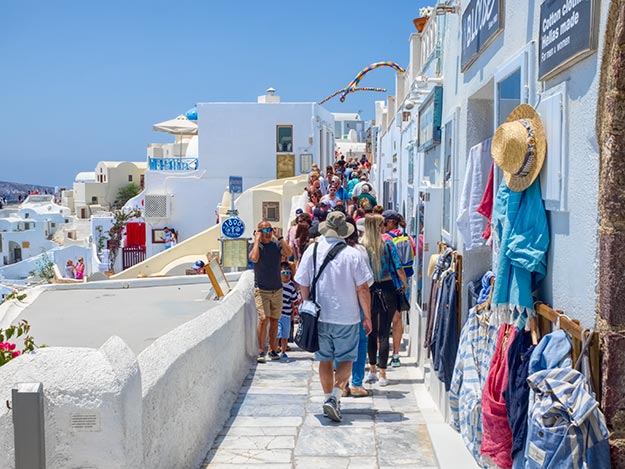
It was my idea of tourist hell. Even more alarming, my Collette tour manager told me this was a light traffic day, as there were no cruise ships in port. Local officials on Santorini are frustrated as well. Last year, authorities limited the number of cruise ships that were allowed to disembark passengers during peak periods. But if this was a light day, I’d hate to be there on a day when even three cruise ships are in port.

Perhaps tourists will overrun the island to the point that people stop coming. On the other hand, a big black volcano squats in the center of the caldera. The last eruption occurred in 1950, followed by an earthquake in 1956 that destroyed many houses. Since then the volcano has been quiet, but geologists tell us it is only sleeping. The only thing we know for certain is that no one can predict what the future holds for the Greek island of Santorini.
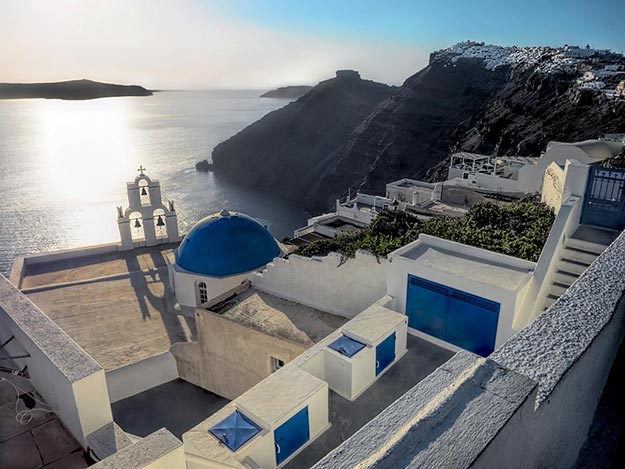
Author’s note: I was a guest of Collette during my “Exploring Greece and Its Islands, featuring Classical Greece, Mykonos & Santorini” tour. However, the receipt and acceptance of complimentary items or services will never influence the content, topics, or posts in this blog. I write the truth, the whole truth, and nothing but the truth.

Enjoyed the article. I’m interested in the history but not in milling about with thousands of tourists so between your pictures (always excellent) and interesting narrative I’ve enjoyed the highlights and avoided the crowds. Thanks.
Hi Joe. Your comment made me laugh out loud. My ex-husband used to say there was no need to travel when he could look at beautiful photos in a magazine, so I’m glad I’ve been able to take you along with me as an armchair traveler. And many thanks for your kind words about my photos.
Very informative article, Barbara! And, LOVE your photos! And, as an aside, I never find your articles too long or too historically documented…it’s always just enough to intrigue!
Thank you so much, Cris. They say that people don’t want to read much anymore, but I think there’s a place for longer content, so good to hear you agree.
I’ve always had a very picturesque image of Santorini in my head. I haven’t really realized how tourist packed it would be. Still would love to visit one day though
It is worth a visit, Juan, and I do understand that the west side of the island is much less touristy.
Fabulous post, Barbara. We visited Santorini in 1996. Before I was travel writing, and long before I was blogging. So I don’t have all the details you’ve included here in my memory banks. I really enjoyed the excavation site at Akrotiri and our week-long stay on Santorini.
Thanks so much, Doreen. I sometimes worry that my posts are too long and too filed with historical facts and figures, so I really appreciated your comment.
Oh yeah, Greece is great. I’ve been a couple of times there and always impressed by the friendliness of the people there.